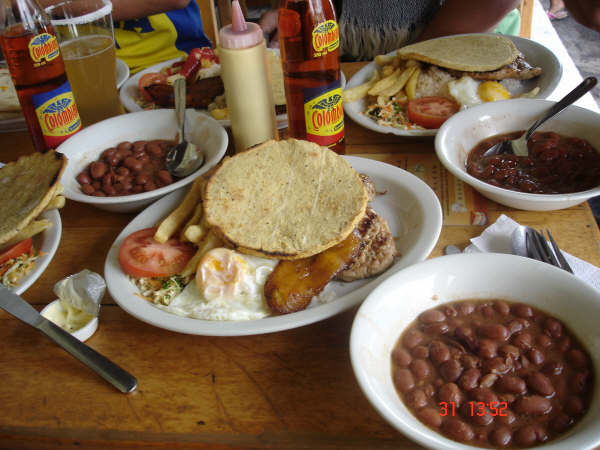
As a nurse, Americas Latino Eco-Festival volunteer Tanja Johnson worked all over the world. She says that everywhere she went, she saw that food was a core part of what made and drove the culture. She says she learned that “food is where we gather, food is community and food is collaboration.”
“In Kosovo there was no money, but there was always enough [food],” she says. “Why? Because they grow their own food and share with one another.”
But it wasn’t until Johnson became pregnant with her daughter that she moved from being an observer to a practitioner.
“I wanted to do the best I could for my daughter, for my fetus,” she says. “Every year I learned more and more. And food became my passion. On a grassroots level, I started talking to all my neighbors about organic milk, organic eggs, and I would get all my friends and neighbors around. And it created a cultural change, and people would thank me.”
Johnson says that by the age of two, her daughter would ask people if things had corn syrup in them, and would then turn them away if they did, and even knew to wear booties on her shoes at farms to avoid impacting the soil.
That’s why Johnson felt that addressing food and its larger cultural implications had to be a part of the Americas Latino Eco-Festival. Food is a key ingredient to culture and its cultivation has major environmental implications. If you can shift the culture of food in the Latino community, then the weight of that population can make large advances for the environment.
And it isn’t just the size of the Latino population that makes it powerful. Johnson says there are unique elements that can address environmental concerns.
For one: “Latin families are historically known for big families, big meals,” she says.
The
size of the meals means they are more likely to be made from scratch,
which makes that cuisine an ideal demographic for organic products.
Then
there’s key ingredients in the cuisine like limes, which can effect pH
balance; cilantro, which Johnson says can function as a detoxifier for
endocrine disrupting pesticides; and corn, which in addition to
being one of the most omnipresent elements in Latino cuisine, is also
primarily farmed using GMO seeds. Get Latinos to reject GMO corn, and
you dramatically shift the market.
And:
“If we can get families to get their corn from their local CSA, then
they wouldn’t be effected by the national price swings,” she says.
To
make that shift happen, Johnson is heading up the Latinovating Food
Fiesta at the Americas Latino Eco-Festival, which will happen on
Saturday, Sept. 13 at the Family Day and Green Markets Fair, which is
part of the Americas Latinos Eco-Festival taking over The Dairy Center
for the Arts from Thursday, Sept. 11-Monday, Sept. 15.
“Last
year we had no food component,” says Johnson. “We threw a huge festival
and we barely had any food. Just some baked goods. We wanted to say
this is how you do it.”
In
addition to the speakers, films and workshops already offered by the
festival, many of which have food themes, there will be a series of
events highlighting ways that people can harness the power of food to
create environmental change.
Events
on the schedule include the Boulder Restaurant Challenge, in which
local restaurants created a Latino-inspired dish using local, organic
and GMO-free ingredients; the Supremo Salsa challenge, in which salsas
made from local organic and GMO-free ingredients will be taste tested
against those that aren’t; an event for kids teaching them how to make
natural snacks from scratch; the “sommellier showdown,” which will be a
sort of Pepsi challenge for wine; and the “stuff it burrito challenge
for dads,” in which local padres can test their burrito-rolling skills.
The fastest dad gets bragging rights and everyone gets to eat their
burrito afterwards.
There will also be a variety of booths and information about CSAs, organic produce and how to green your family’s dinner table.
“We
know statistically that the Latino community doesn’t have as much
access to these foods because of their socio-economic status,” Johnson
says.
There will also be the “Farm to Laughter” event, which will offer up a muy fancy farm dinner before a performance from Rick Najera, a former writer on In Living Color, and just after a screening of Food Chains, from producer Eva Longoria. That dinner costs $80 and includes pre-dinner drinks from Suerte Tequila.
Of
course, Johnson isn’t so naïve as to believe all it will take is a big
shindig like this and the world will immediately self-correct. But she
feels that Boulder is a unique place to seed that larger change, because
of its existing cultural interest in healthy food, because of its
affluence making healthy food more accessible, and because of its
relative closeness to large agricultural assets like farms, and smaller
ones like fruit trees located along Boulder Creek.
“It starts at the local level,” she says.
“We’re
not going to change it up here [at the national level] because there’s
too much Big Ag. We’re going to change it with our people sand our local
farmers. And from our local farmers we’ll see the political change.
Boulder is the perfect place to do it, and we’ll see that change
measured in the next three to five years.”
But you’ll be able to taste that change on Saturday, Sept. 13.
Respond: [email protected]














